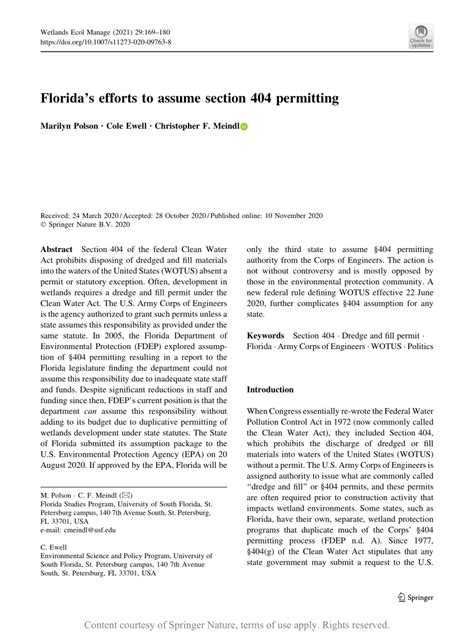-
Table of Contents
- Understanding Florida 404 Permitting: Navigating the Regulatory Landscape
- What is a Florida 404 Permit?
- Types of Projects Requiring a 404 Permit
- The Florida 404 Permitting Process
- 1. Pre-Application Consultation
- 2. Permit Application Submission
- 3. Public Notice and Comment Period
- 4. Environmental Review
- 5. Permit Decision
- Challenges and Considerations
- Case Study: The Everglades Restoration Project
- Conclusion
Understanding Florida 404 Permitting: Navigating the Regulatory Landscape
Florida is known for its beautiful beaches, diverse ecosystems, and abundant water resources. However, the state’s unique Geography also presents challenges when it comes to development and construction projects. One of the key regulatory hurdles that developers and landowners must navigate is the Florida 404 permitting process.
What is a Florida 404 Permit?
A Florida 404 permit, also known as a Section 404 permit, is issued by the U.S. Army Corps of Engineers under Section 404 of the Clean Water Act. This permit is required for any project that involves the discharge of dredged or fill material into waters of the United States, including wetlands.
Types of Projects Requiring a 404 Permit
- Construction of new roads or bridges
- Dredging and filling activities
- Development of waterfront properties
- Expansion of marinas or ports
The Florida 404 Permitting Process
The Florida 404 permitting process can be complex and time-consuming. It typically involves the following steps:
1. Pre-Application Consultation
Before submitting a permit application, it is advisable to consult with the U.S. Army Corps of Engineers to discuss the project and identify potential issues or concerns.
2. Permit Application Submission
Once the project has been reviewed and any necessary revisions made, the permit application can be submitted to the U.S. Army Corps of Engineers for review.
3. Public Notice and Comment Period
After the permit application is submitted, a public notice is issued, and interested parties have the opportunity to submit comments or objections to the proposed project.
4. Environmental Review
The U.S. Army Corps of Engineers will conduct an environmental review of the project to assess potential impacts on water quality, wildlife, and wetlands.
5. Permit Decision
After completing the review process, the U.S. Army Corps of Engineers will issue a decision on whether to approve, deny, or conditionally approve the permit.
Challenges and Considerations
Obtaining a Florida 404 permit can be challenging due to the stringent environmental regulations and the need to demonstrate compliance with state and federal laws. Developers and landowners must carefully consider the potential impacts of their projects on the environment and Work closely with regulatory agencies to address any concerns.
Case Study: The Everglades Restoration Project
One of the most significant environmental restoration projects in Florida is the Everglades Restoration Project, which aims to restore the natural flow of water through the Everglades ecosystem. This project required numerous permits, including Florida 404 permits, due to the extensive dredging and filling activities involved.
Conclusion
In conclusion, navigating the Florida 404 permitting process requires careful planning, coordination, and compliance with environmental regulations. Developers and landowners must be prepared to address potential challenges and work closely with regulatory agencies to ensure that their projects meet the necessary requirements. By understanding the permitting process and seeking expert guidance, stakeholders can successfully navigate the regulatory landscape and achieve their development goals while protecting Florida’s valuable natural resources.




